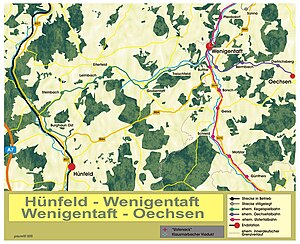Wenigentaft-Mansbach-Oechsen railway line
| Little WOeE-Oechsen | |||||||||||||||||||||||||||||||||||||||||||||||||||||
|---|---|---|---|---|---|---|---|---|---|---|---|---|---|---|---|---|---|---|---|---|---|---|---|---|---|---|---|---|---|---|---|---|---|---|---|---|---|---|---|---|---|---|---|---|---|---|---|---|---|---|---|---|---|
| Course book section (DB) : | 190w (1944) | ||||||||||||||||||||||||||||||||||||||||||||||||||||
| Gauge : | 1435 mm ( standard gauge ) | ||||||||||||||||||||||||||||||||||||||||||||||||||||
|
|||||||||||||||||||||||||||||||||||||||||||||||||||||
The Wenigentaft-Mansbach-Oechsen railway was a single-track, non-electrified railway line in Thuringia . It was built and operated by the Wenigentaft-Oechsener Eisenbahn (WOeE). The route was primarily intended for the transport of mineral resources .
course
The 10 km long standard-gauge line branched off in the Grand Duchy of Saxony-Weimar-Eisenach from the Wenigentaft - Mansbach railway junction in the Ulster valley in an easterly direction from the Ulstertal Railway and led through Buttlar and past Bermbach and Masbach through the Vorder Rhön to the end point Oechsen , which had around 700 inhabitants at the time.
history
The potash mining unions Heiligenmühle (based in Oldisleben ) and Mariengart planned in 1909 to sink two potash shafts west of Oechsen in Niederoechsen . For their infrastructural development, plans for a railway line began in 1910, whereby a route to the Wenigentaft-Mansbach station and a connection through the Oechse valley to Vacha was weighed up. It was decided to take the 1.5 kilometer shorter route to Wenigentaft, and the municipality of Oechsen contributed 20,000 RM, on the condition that the railway line should also serve public transport. Construction began in January 1911.
The railway was opened for freight traffic on August 15, 1912, although potash mining in the two Oechsen shafts came to a standstill as early as 1914 due to water ingress. The always modest passenger traffic began on March 28, 1917. In 1920, a charging station for basalt from the open-cast mine in the north of Dietrichsberg was created in the district of Wölferbütt . In 1924 the Thuringian hard stone works (from 1926: Heinrich Hagemeier GmbH Masbach (Rhön) ) took over the basalt quarry and the railway line.
The operation was led by the central administration for Secundairbahnen Herrmann Bachstein . In 1928 29,712 people and 72,813 tons of goods were transported. From the end of March 1945 to the beginning of June 1945, rail traffic was idle as a result of the final phase of World War II , after which traffic was gradually resumed. From April 1, 1949, the Deutsche Reichsbahn took over the management and operation of the line from the Hagemann company, which was expropriated and nationalized in 1951.
All operations ended on October 4, 1952, because the inner-German border changed several times on the Ulstertalbahn line and on the site of Wenigentaft-Mansbach station and the line was thus isolated from the Deutsche Reichsbahn network. In 1953 the track systems were dismantled. Parts of the route are now used by the Ulster Cycle Path and the Oechsenbahn Cycle Path, among others .
literature
- Harald Rockstuhl : The History of the Wenigentaft-Oechsener Railway 1912–1952. Rockstuhl Verlag, Bad Langensalza 2000, ISBN 3-932554-00-0 .
Web links
- Course book 1944
- Wenigentaft - Oechsen (Oechsentalbahn). on: vergierter-bahnen.de
Individual evidence
- ↑ Karl Schlemmer: Oechsenbahn cycle path (Wenigentaft – Niederoechsen) 10 km. In: bahntrassenradwege.de. Retrieved May 10, 2016 .

